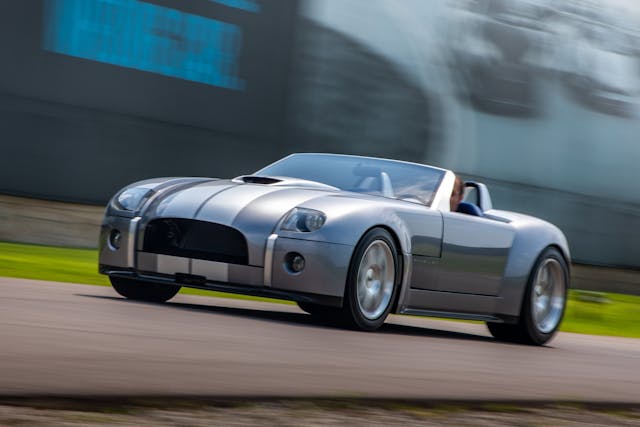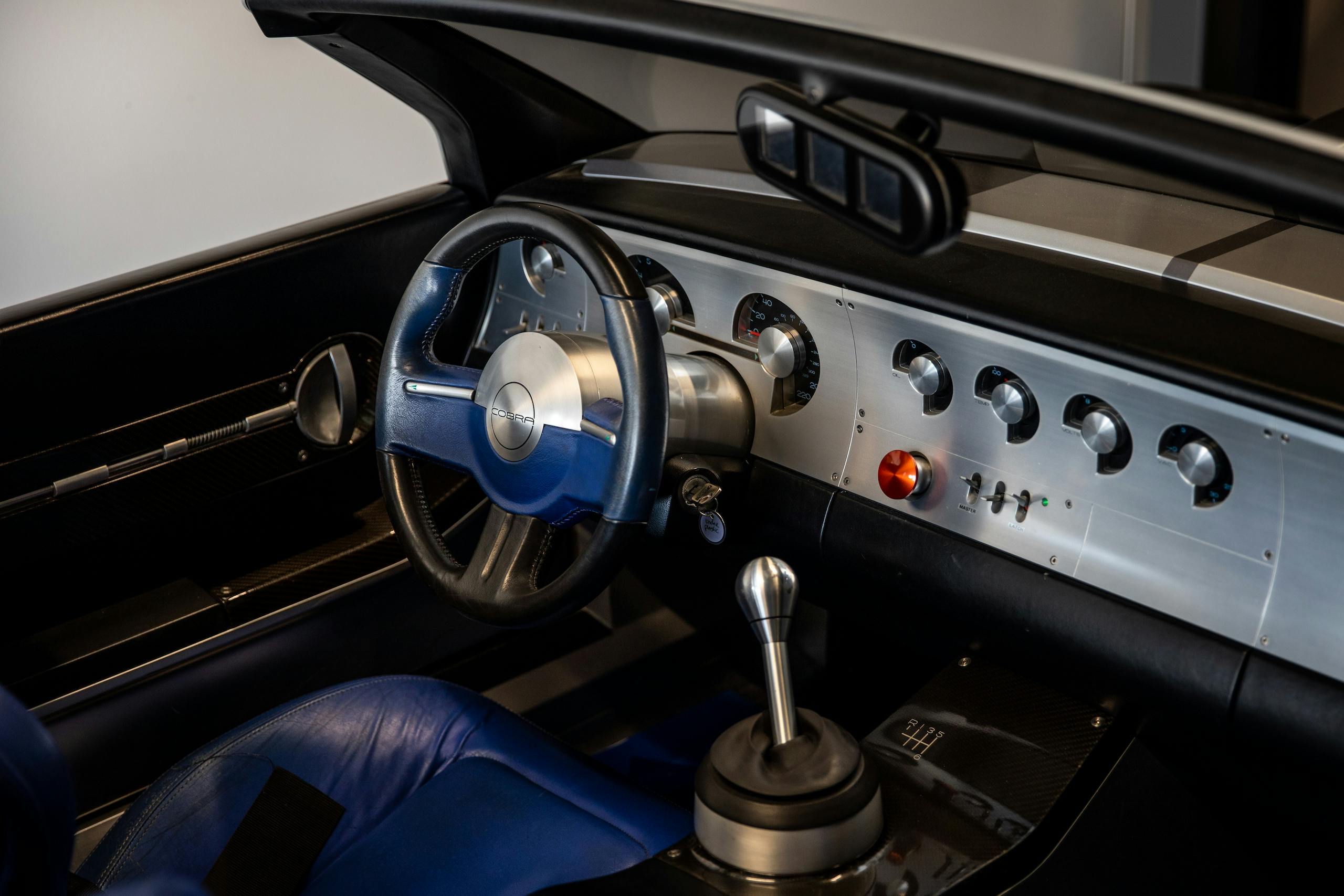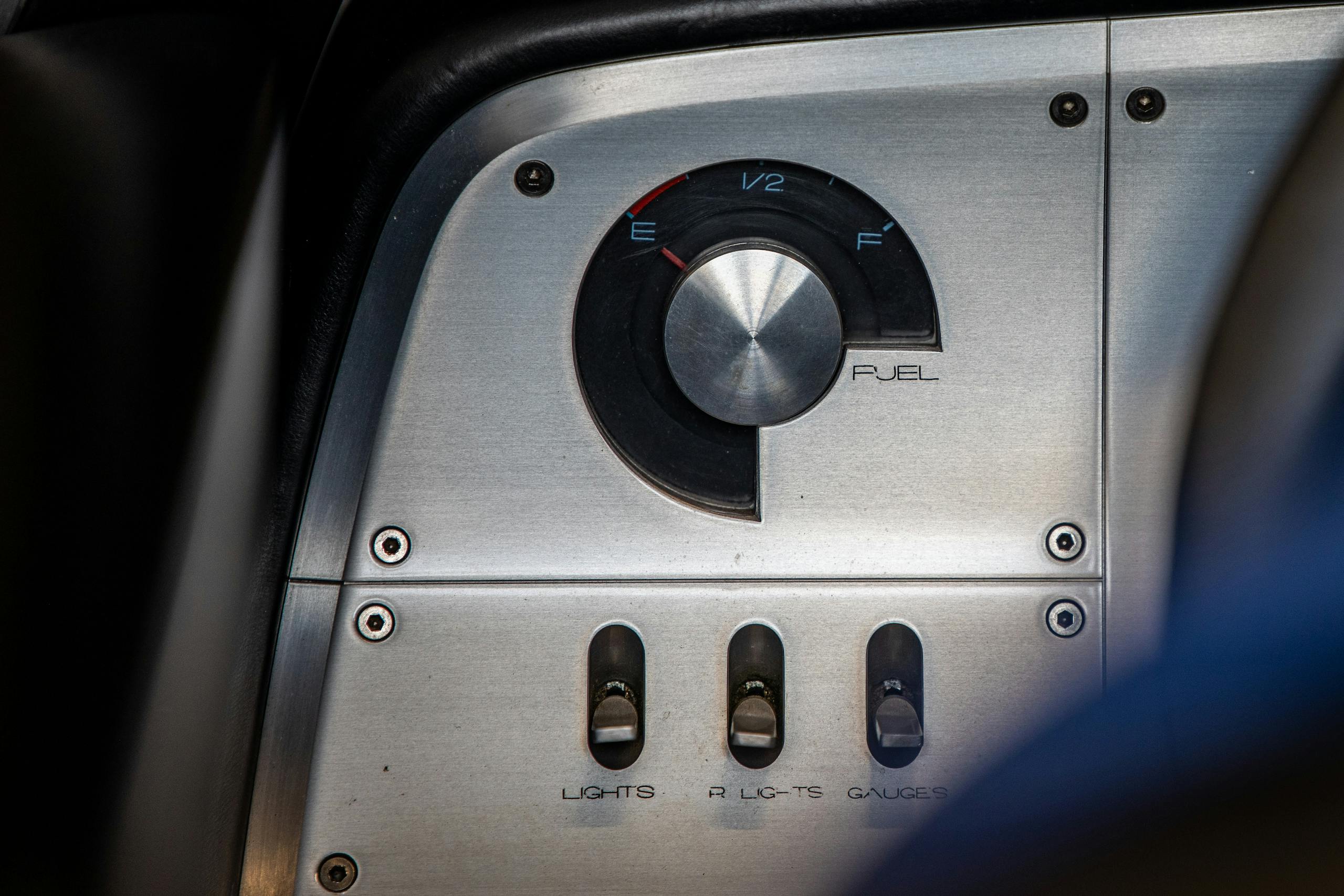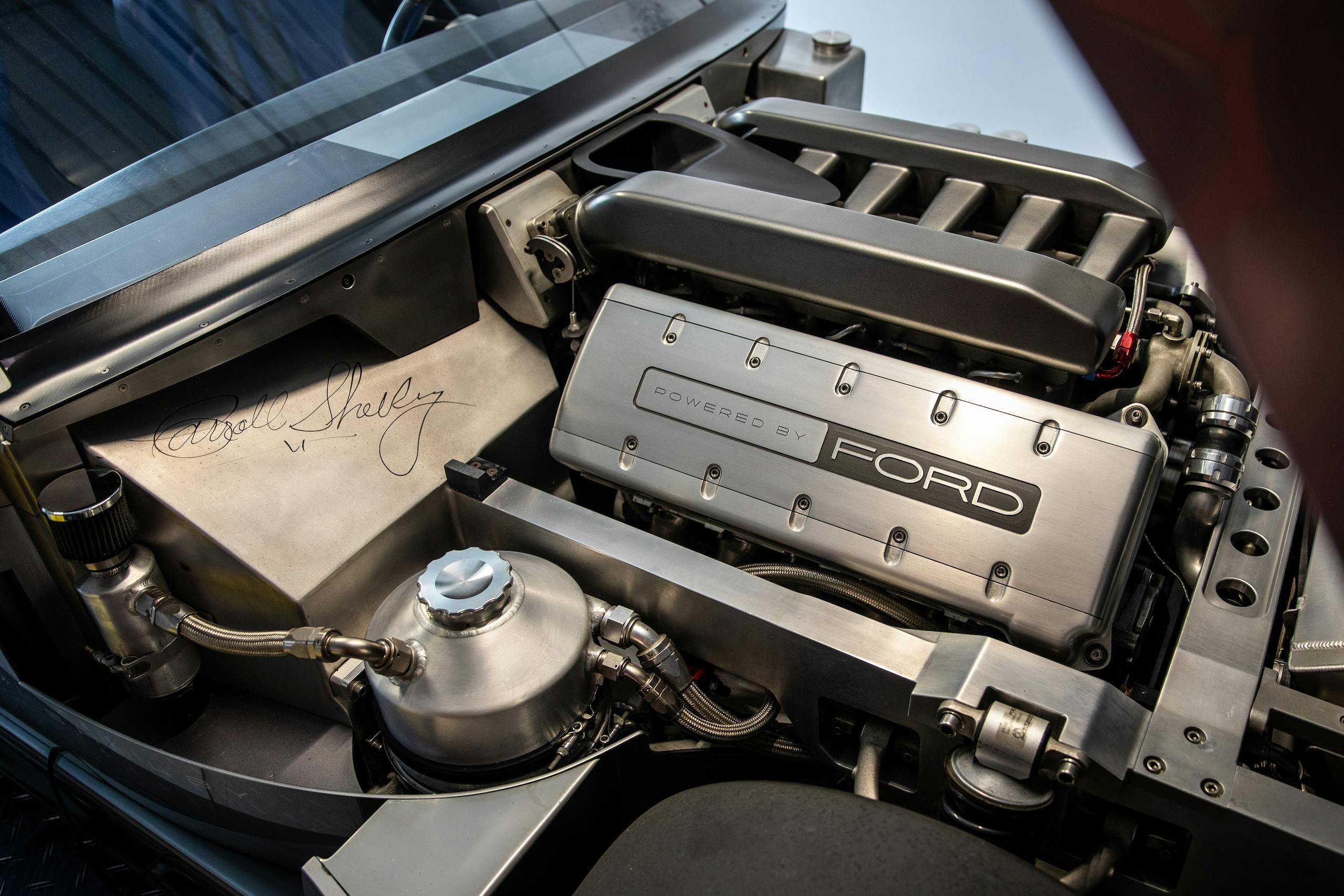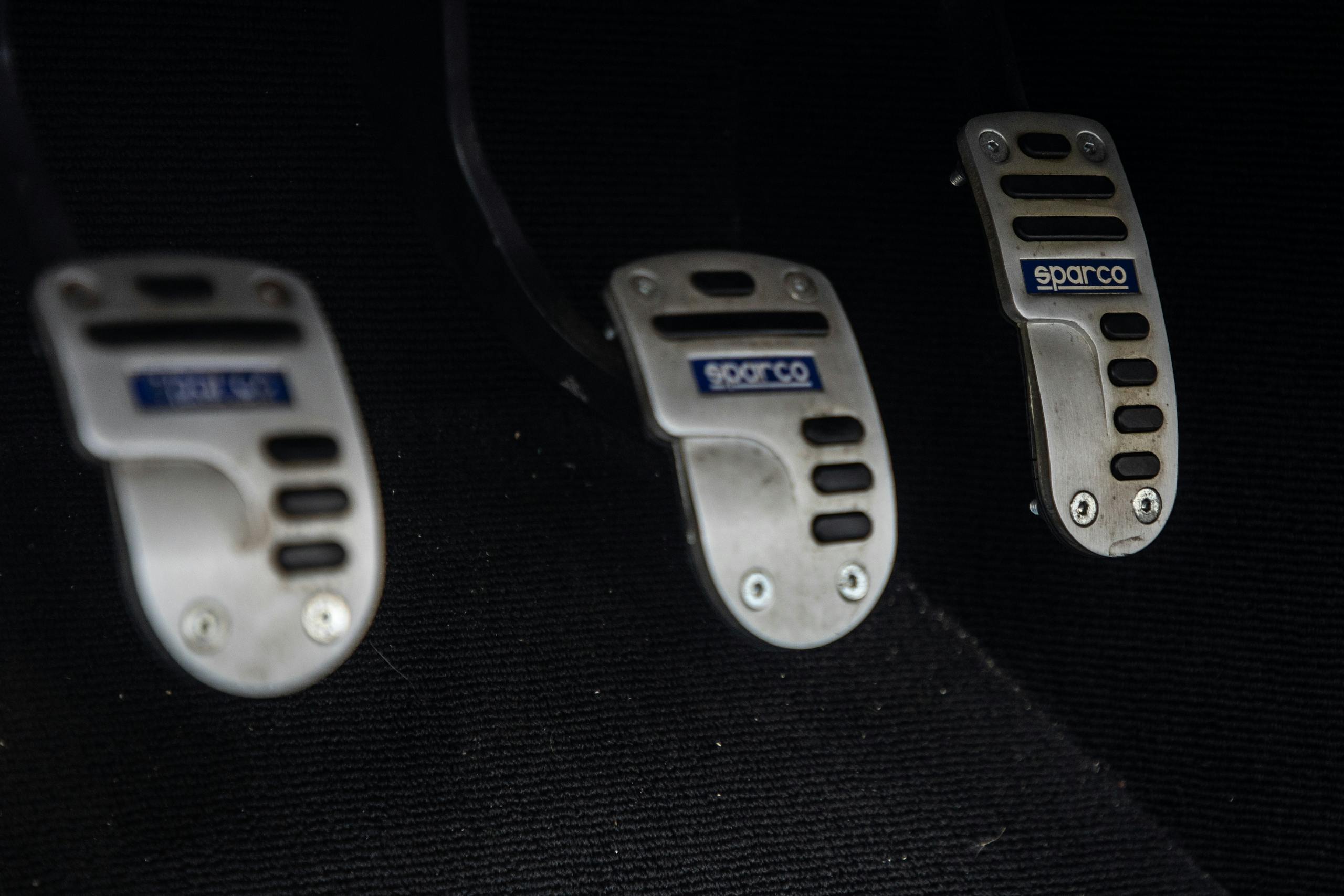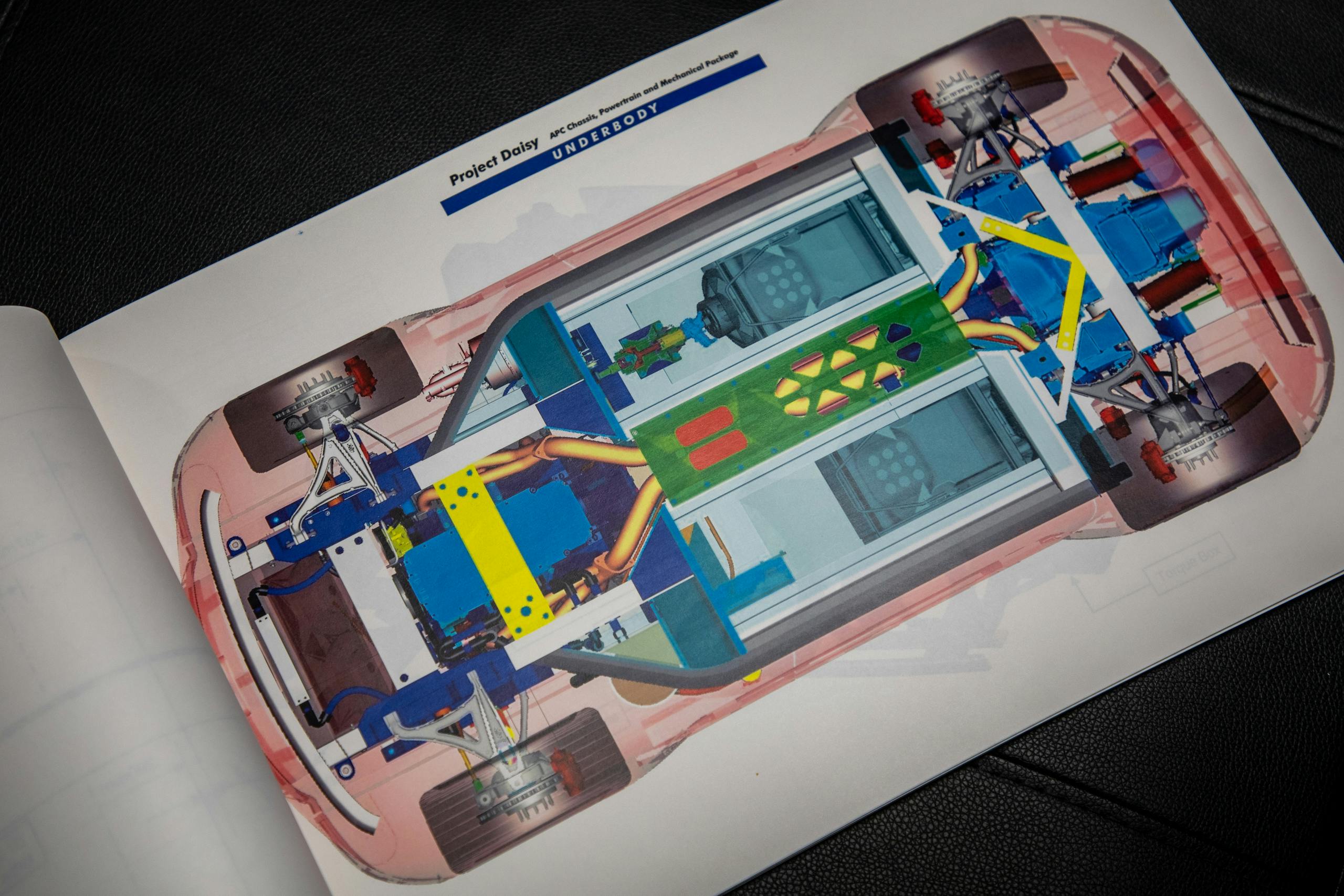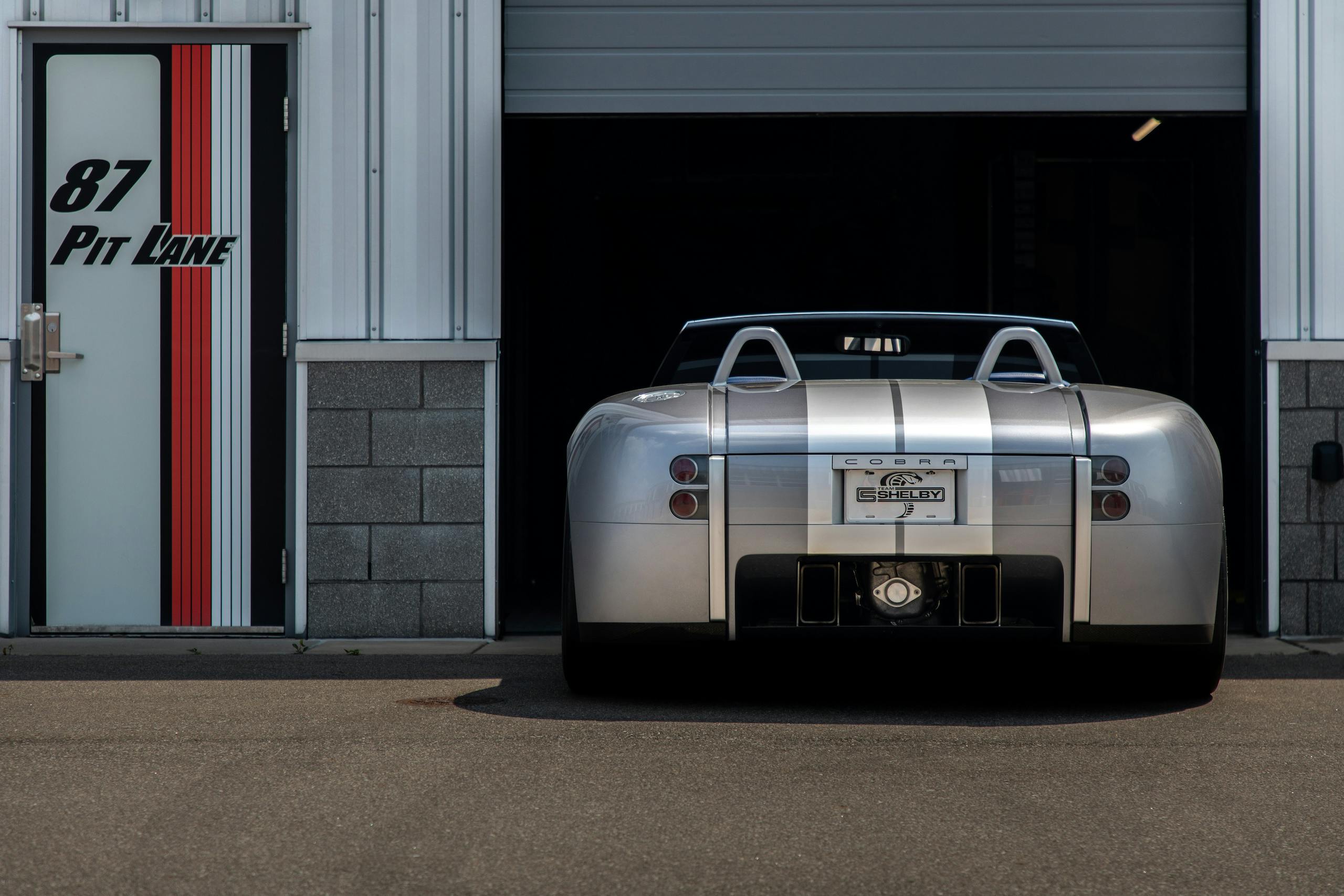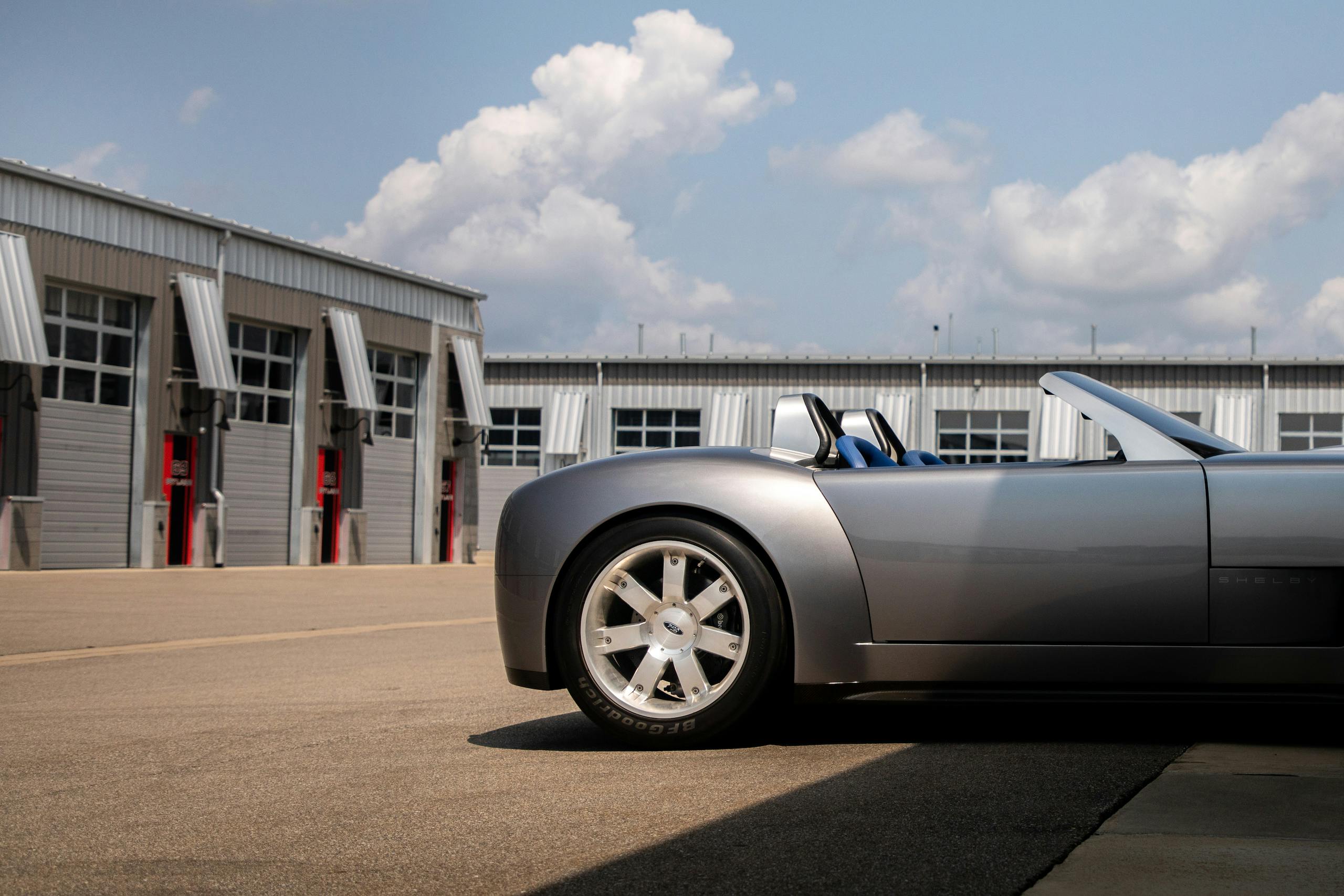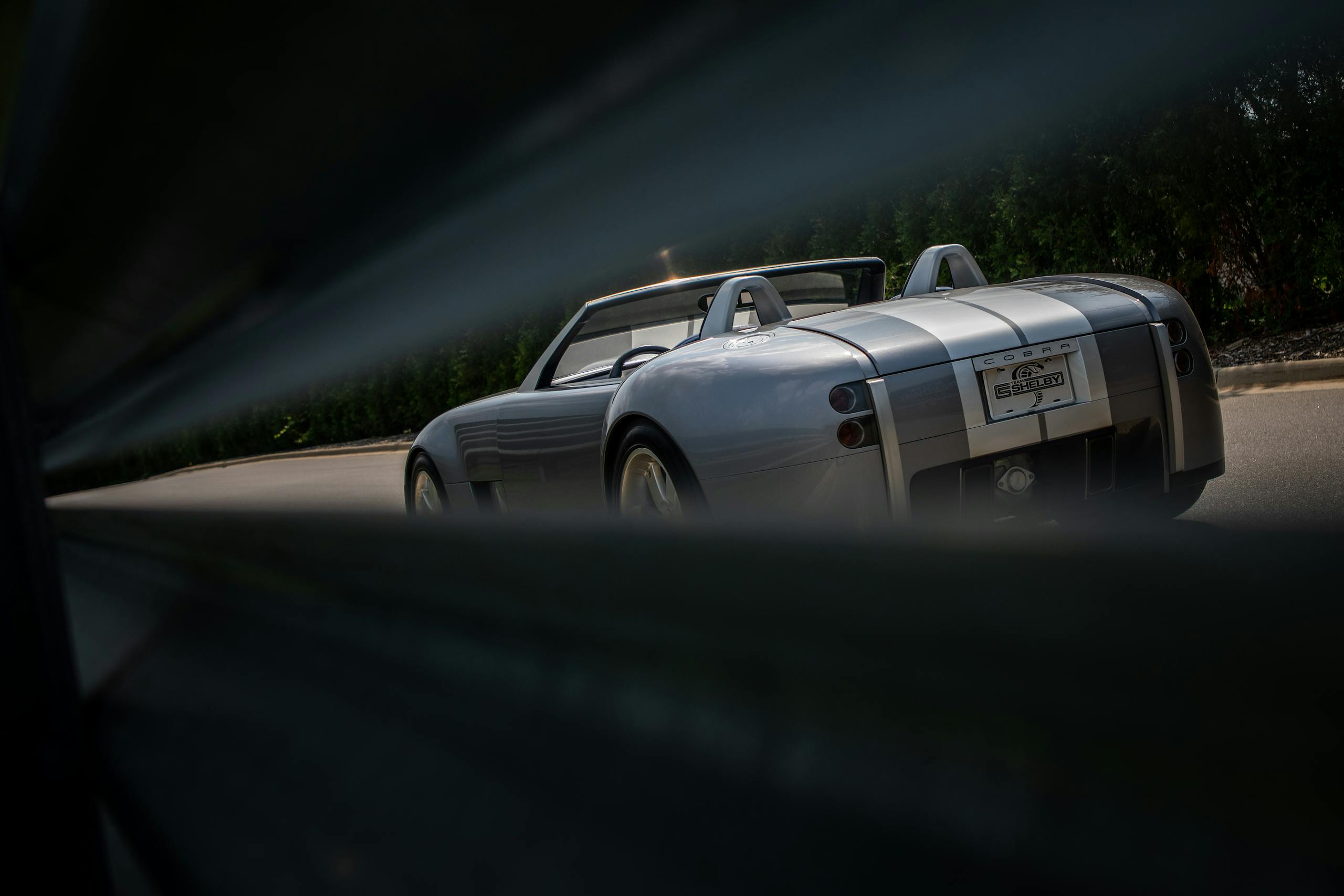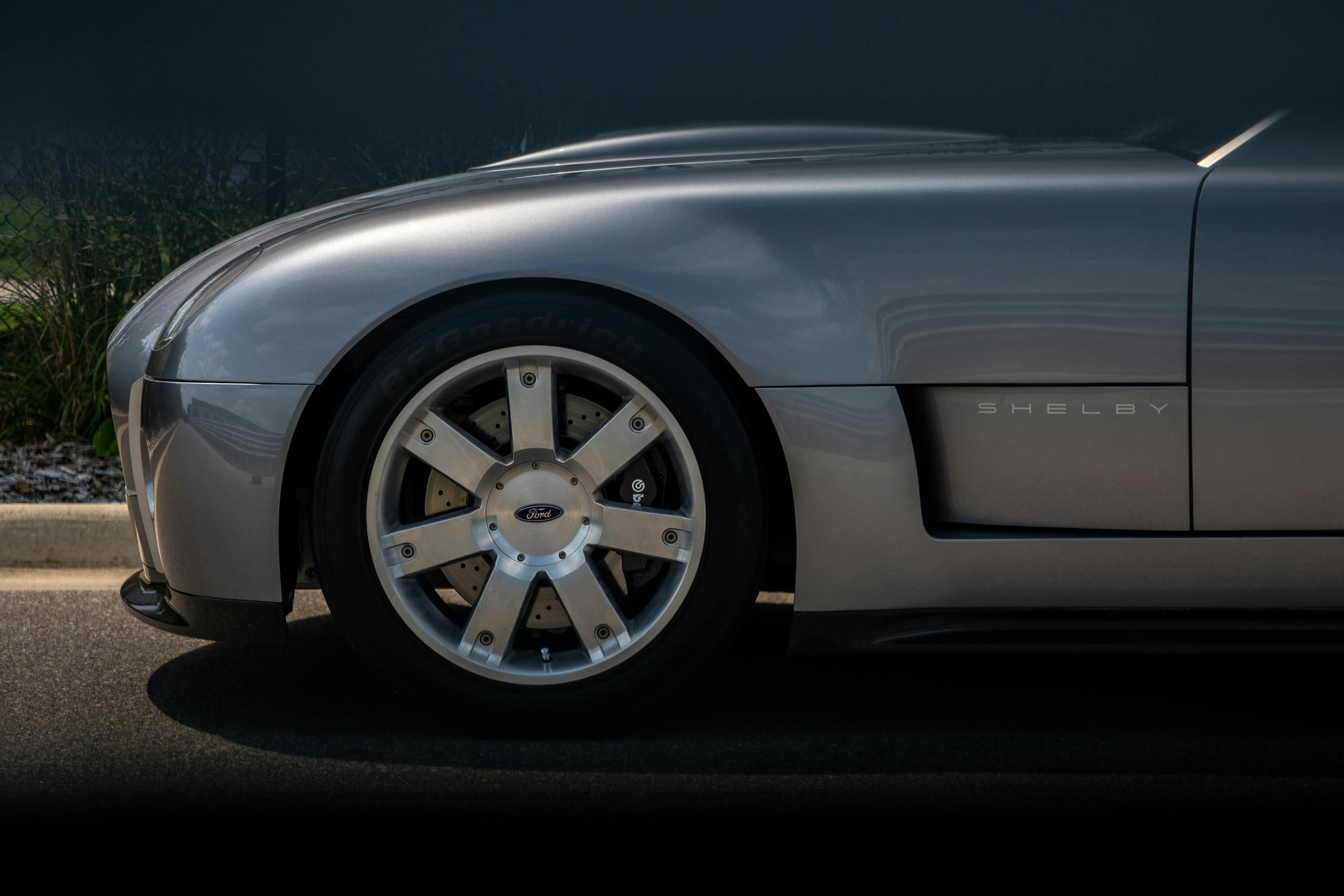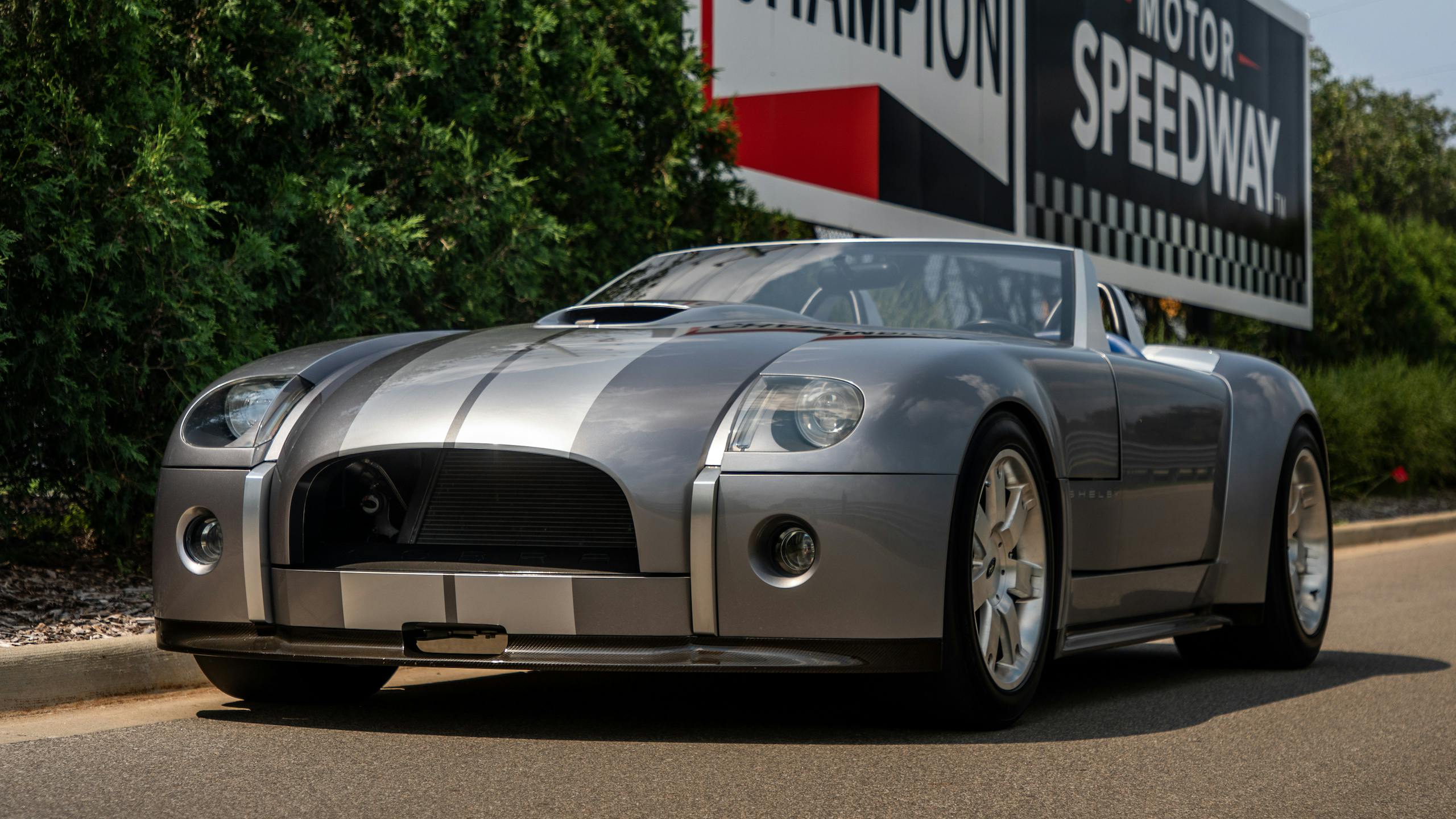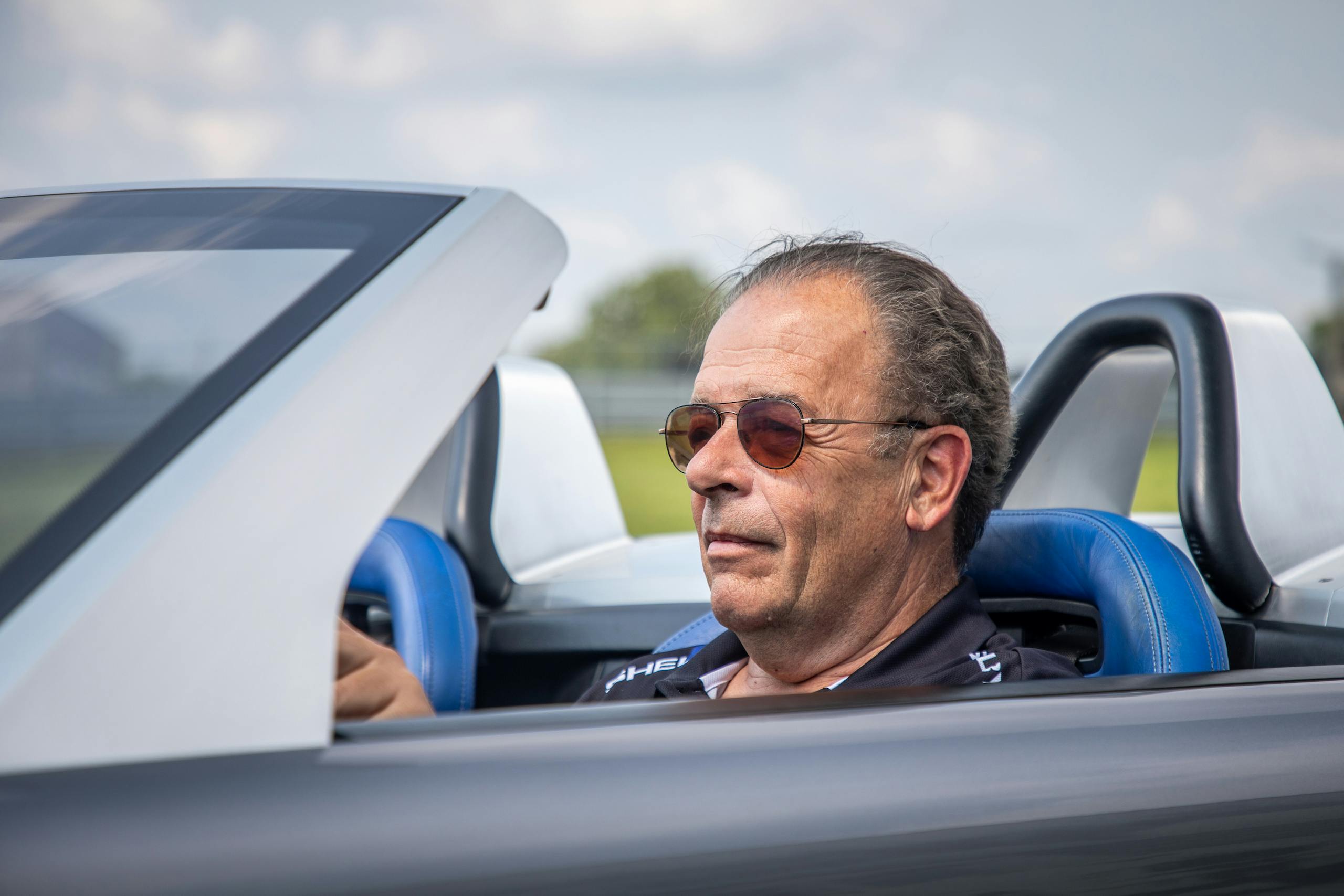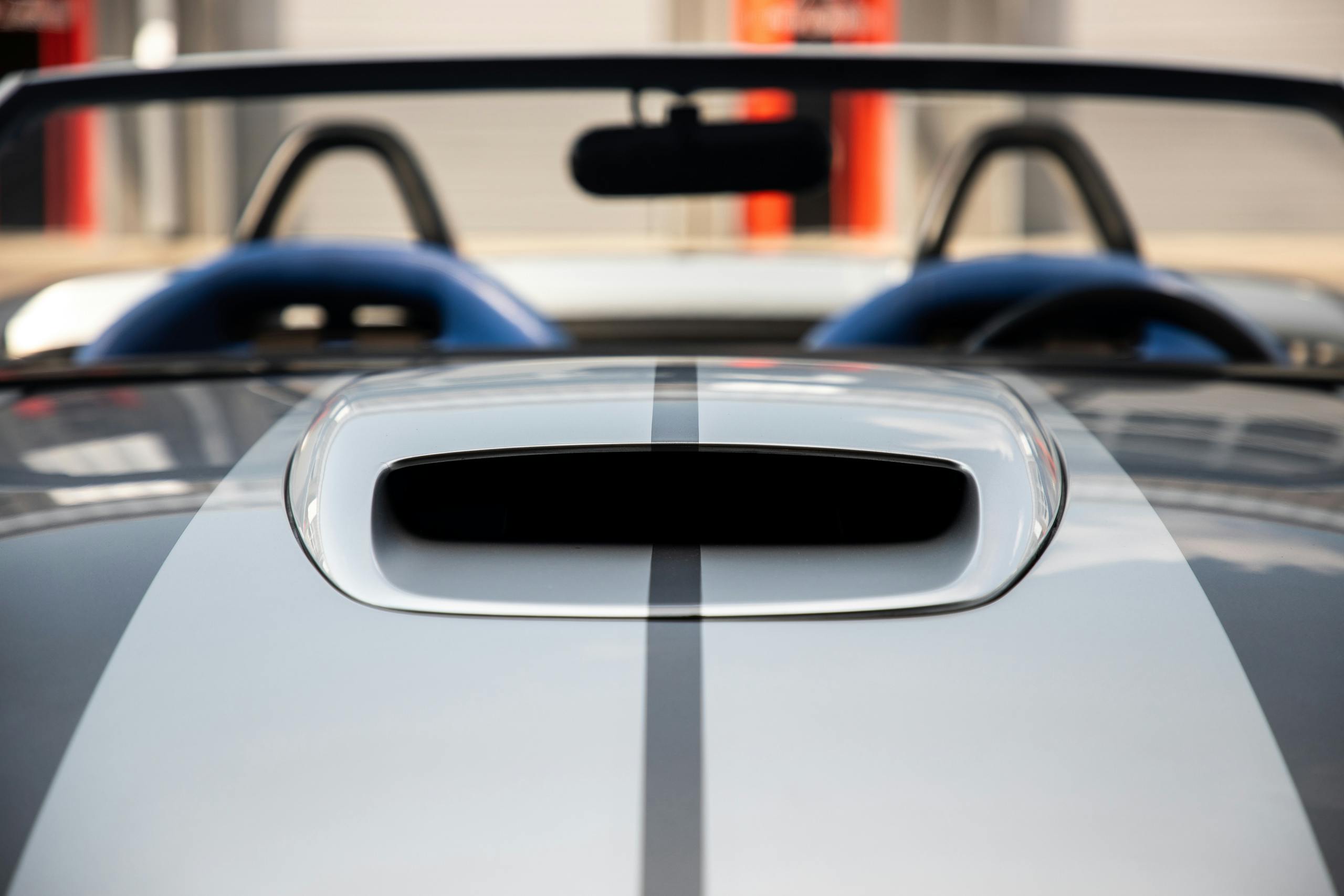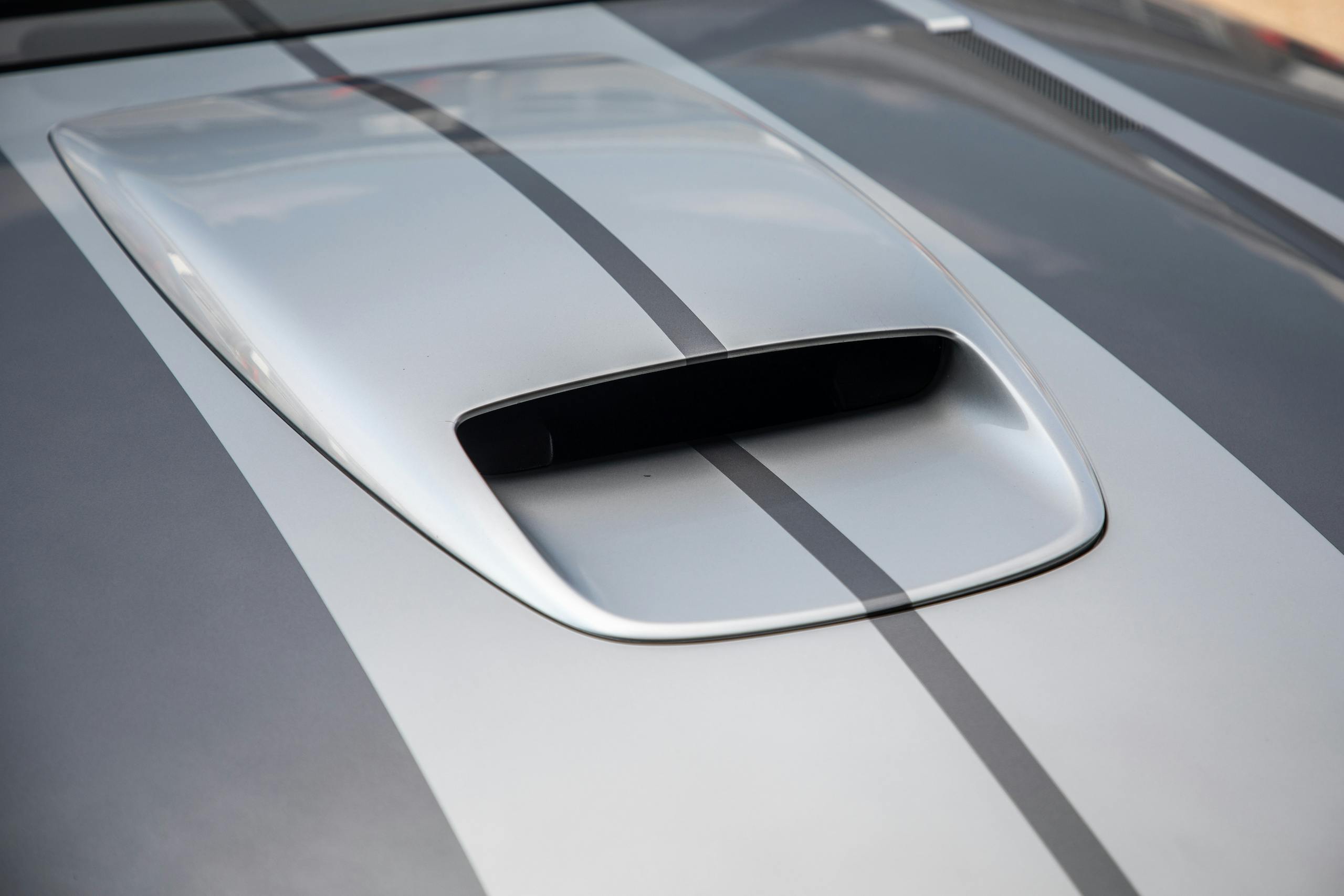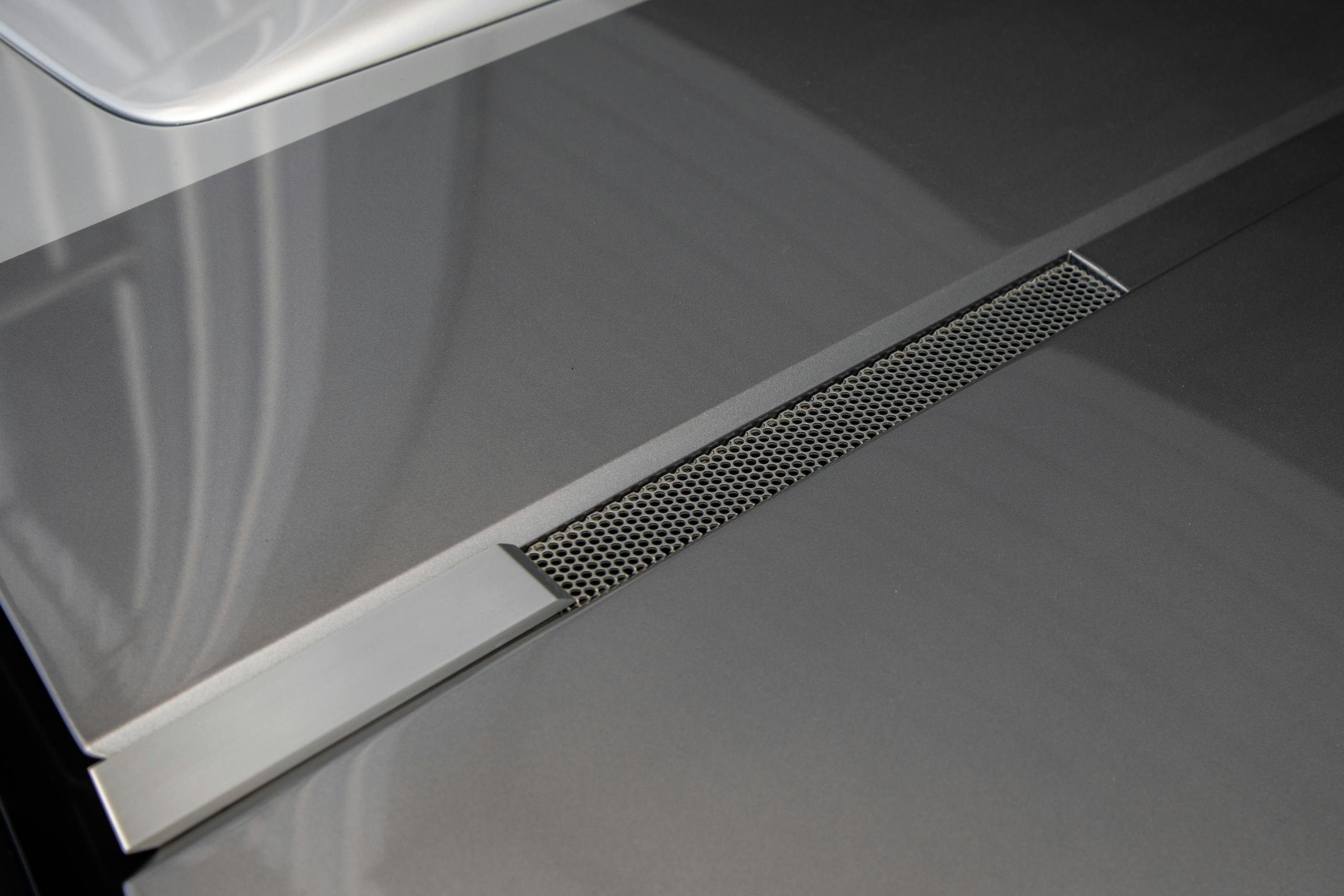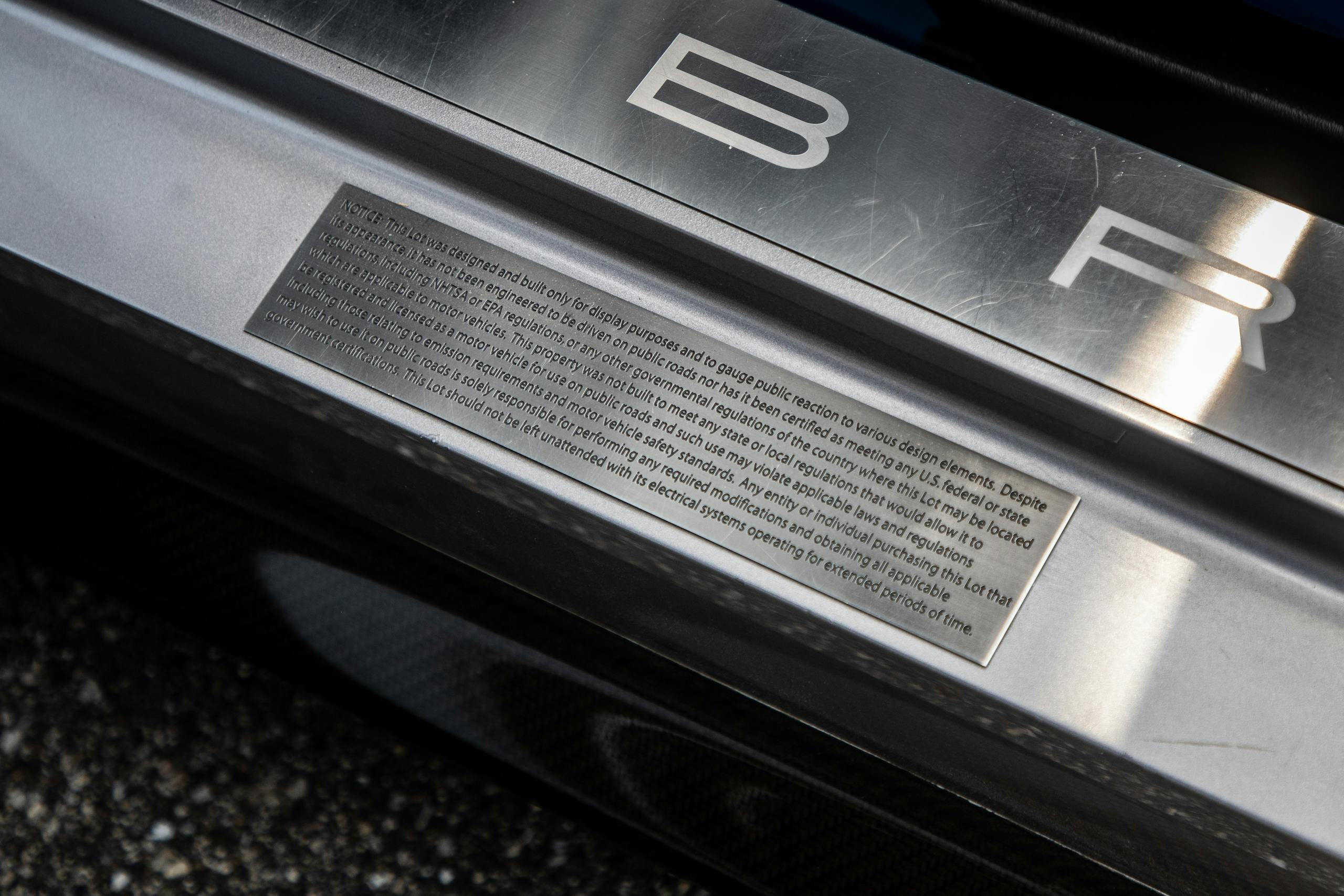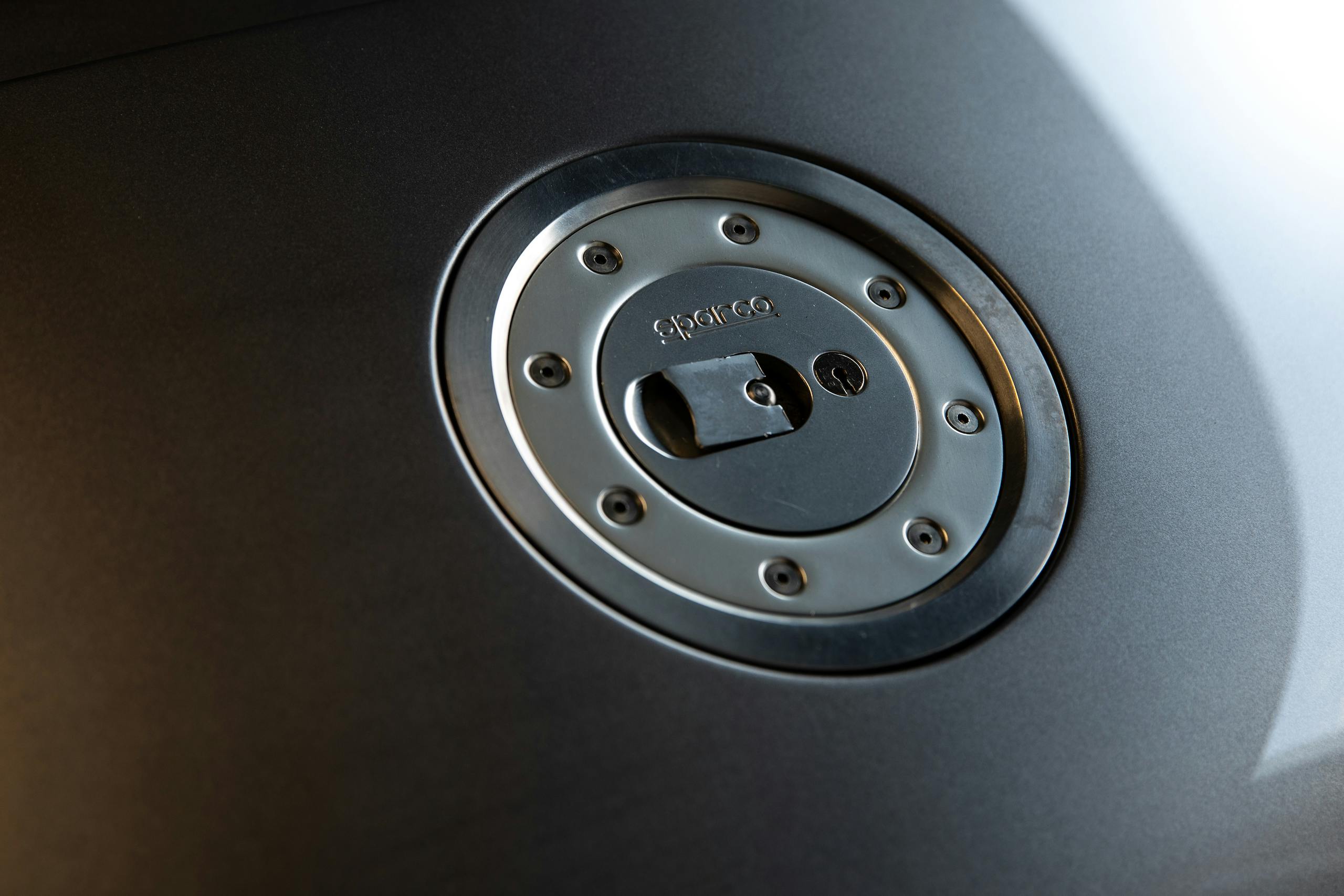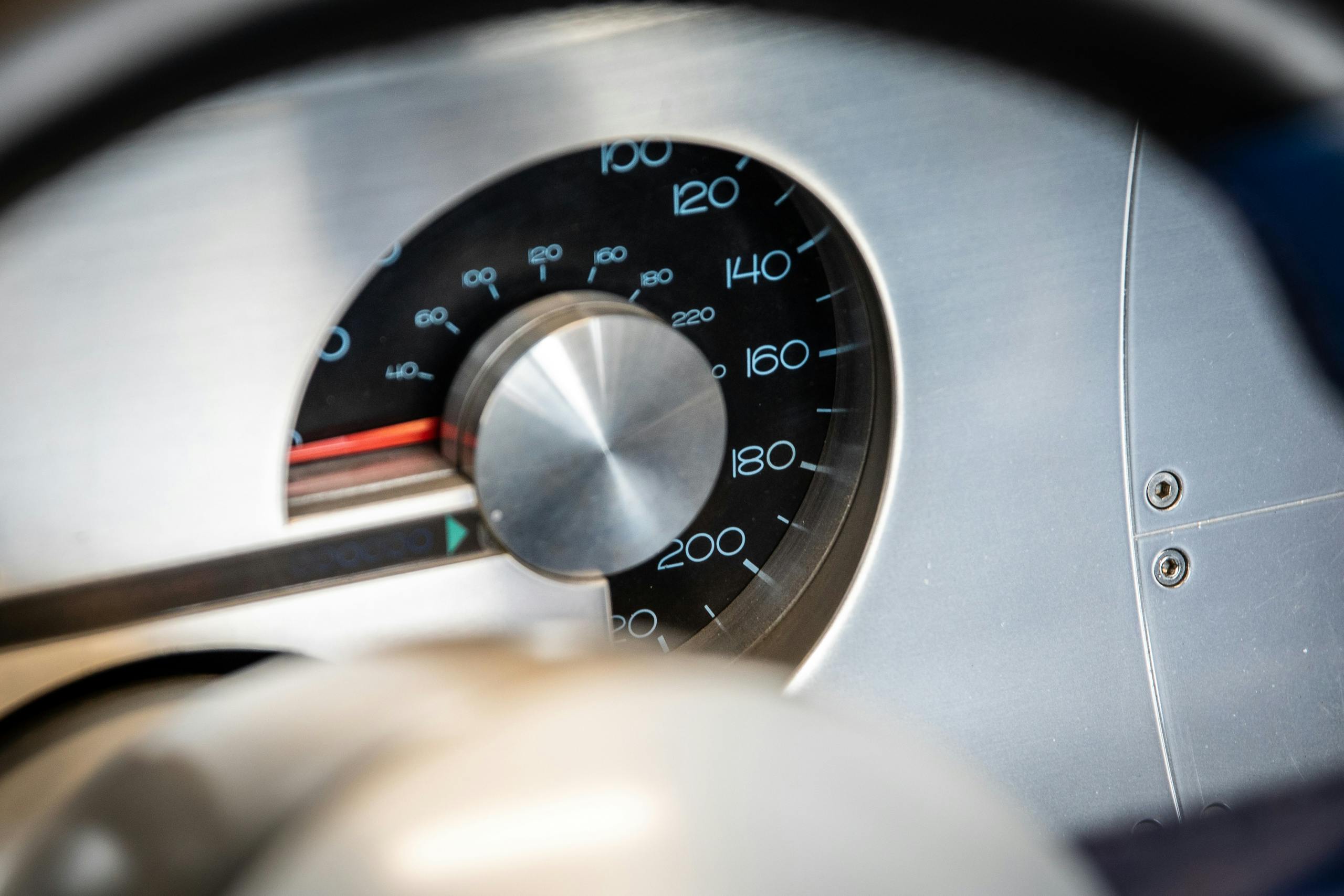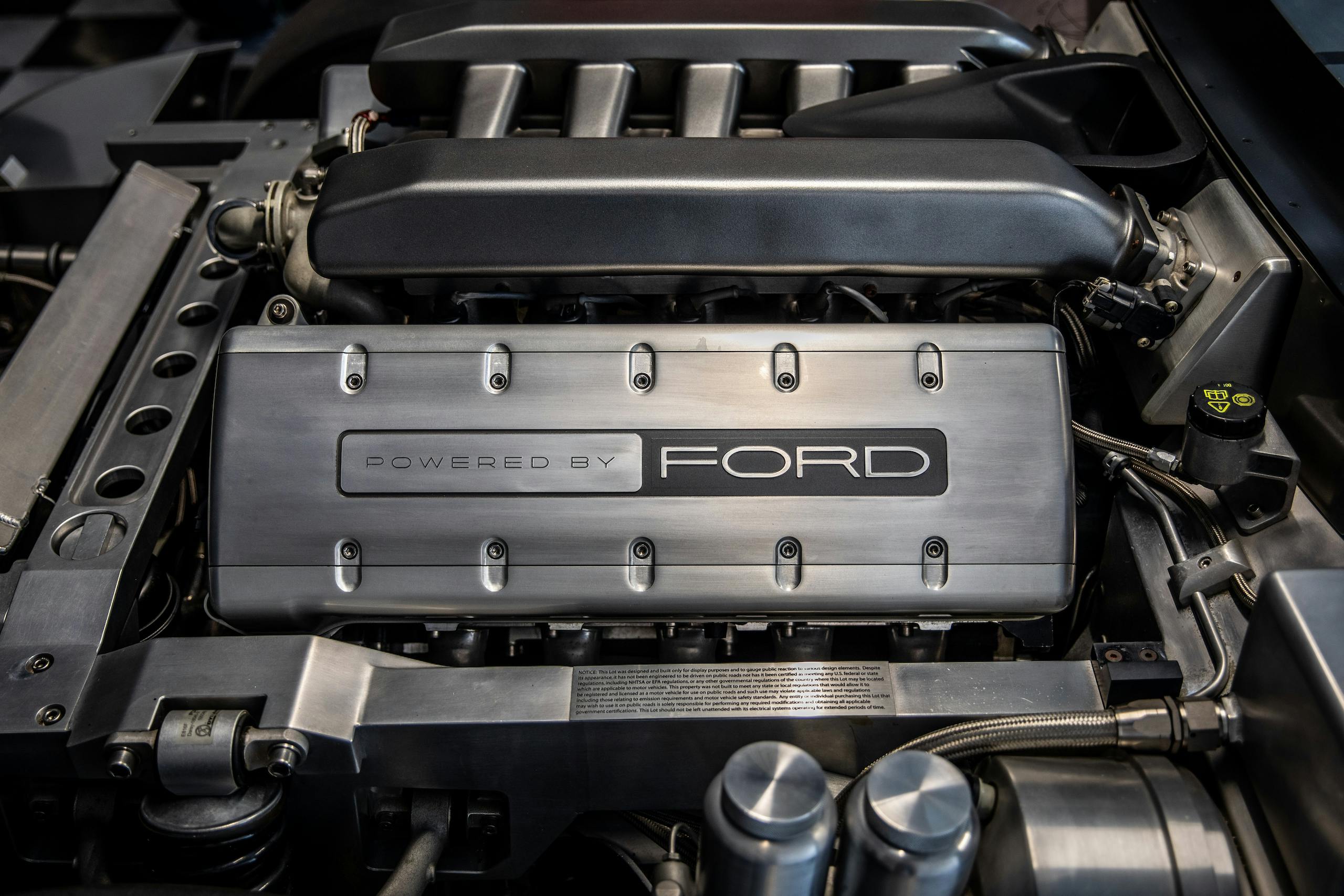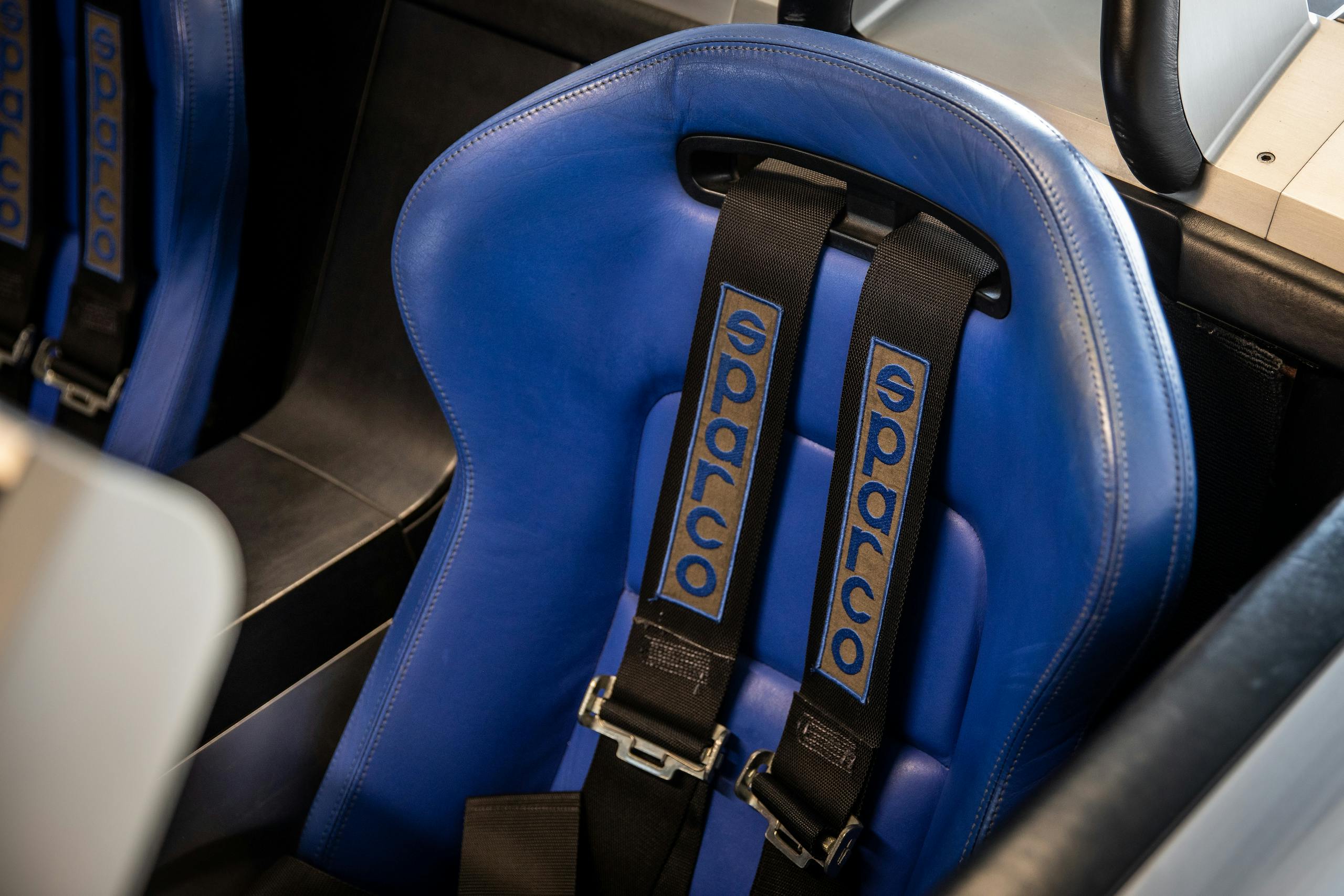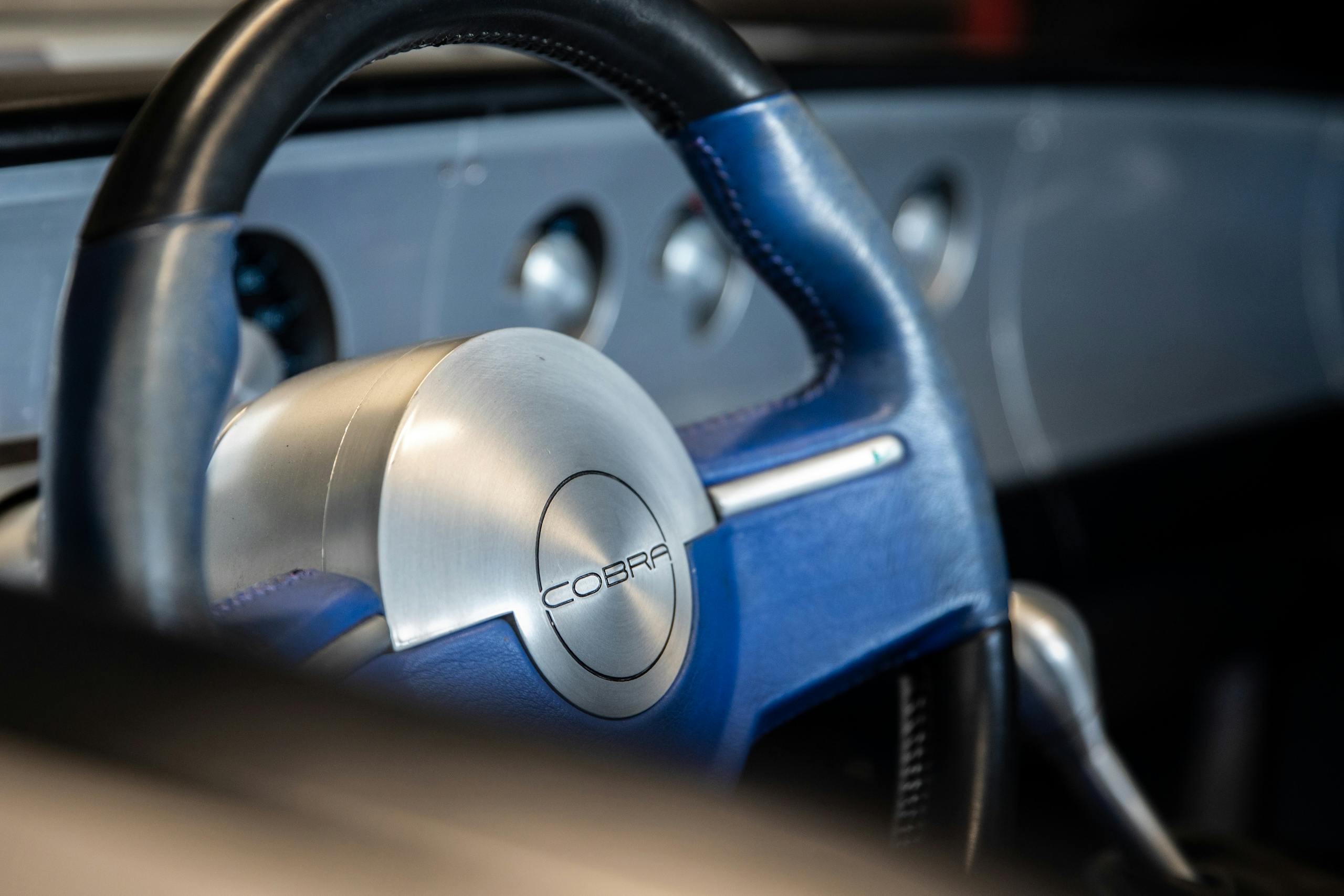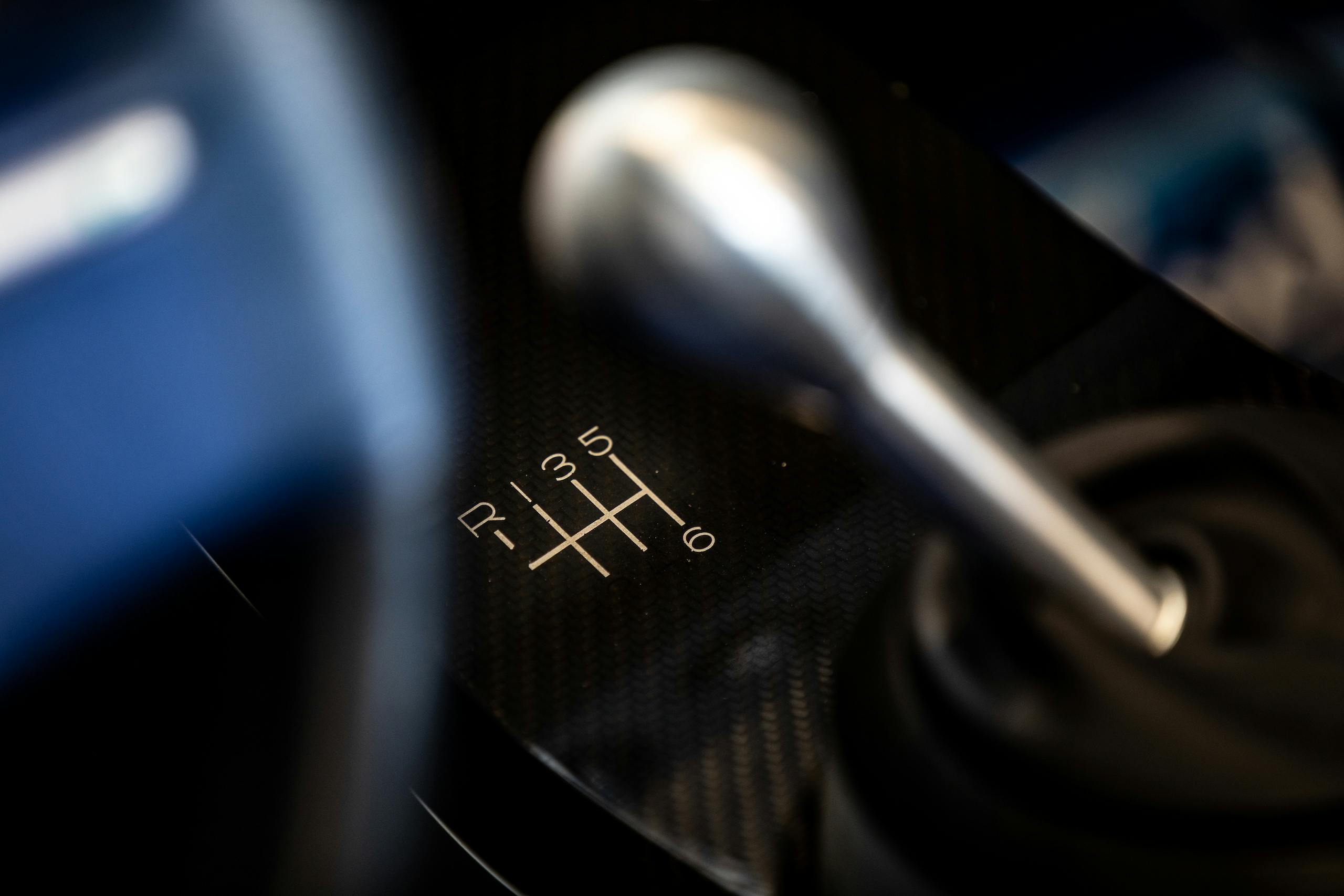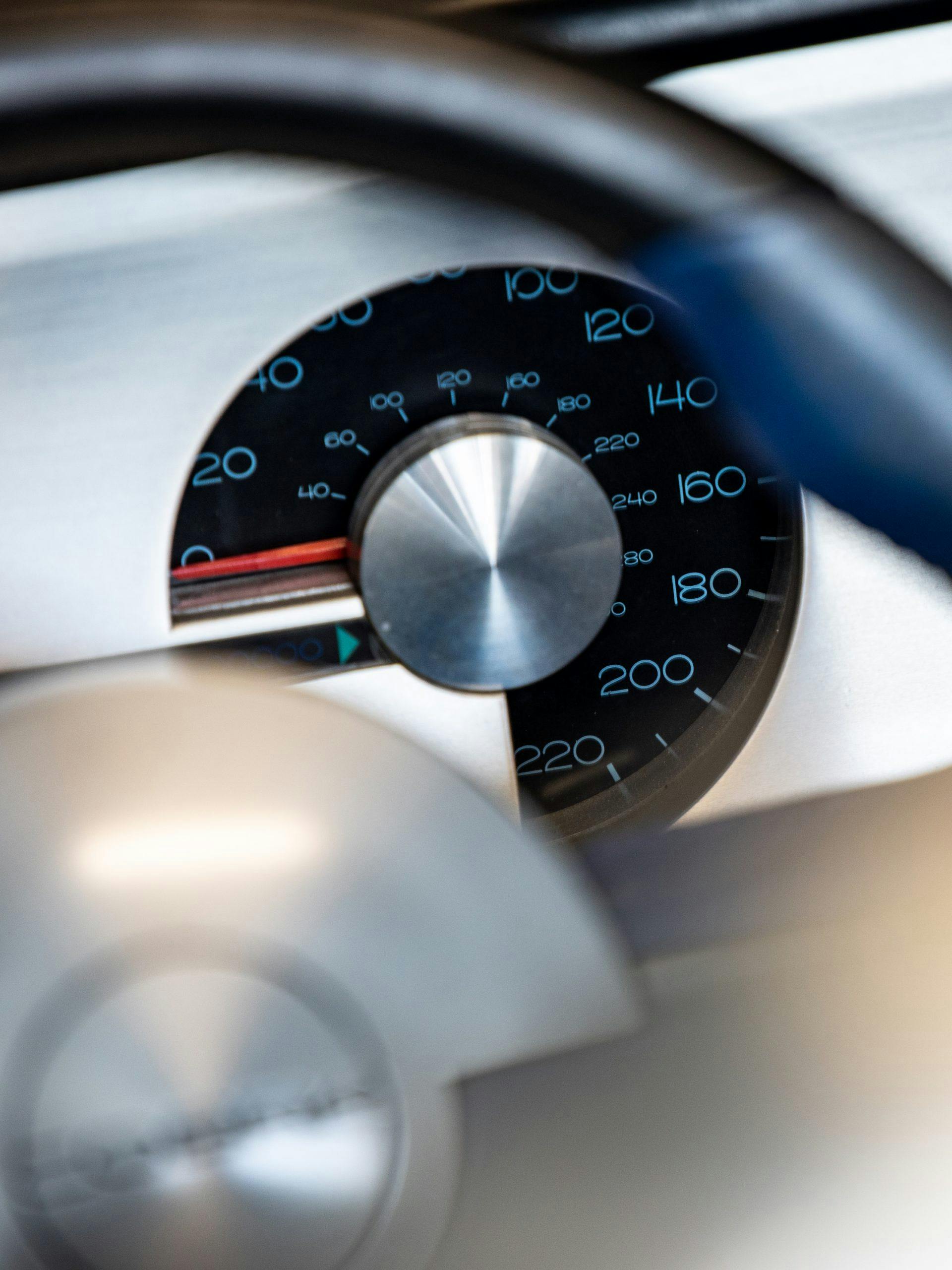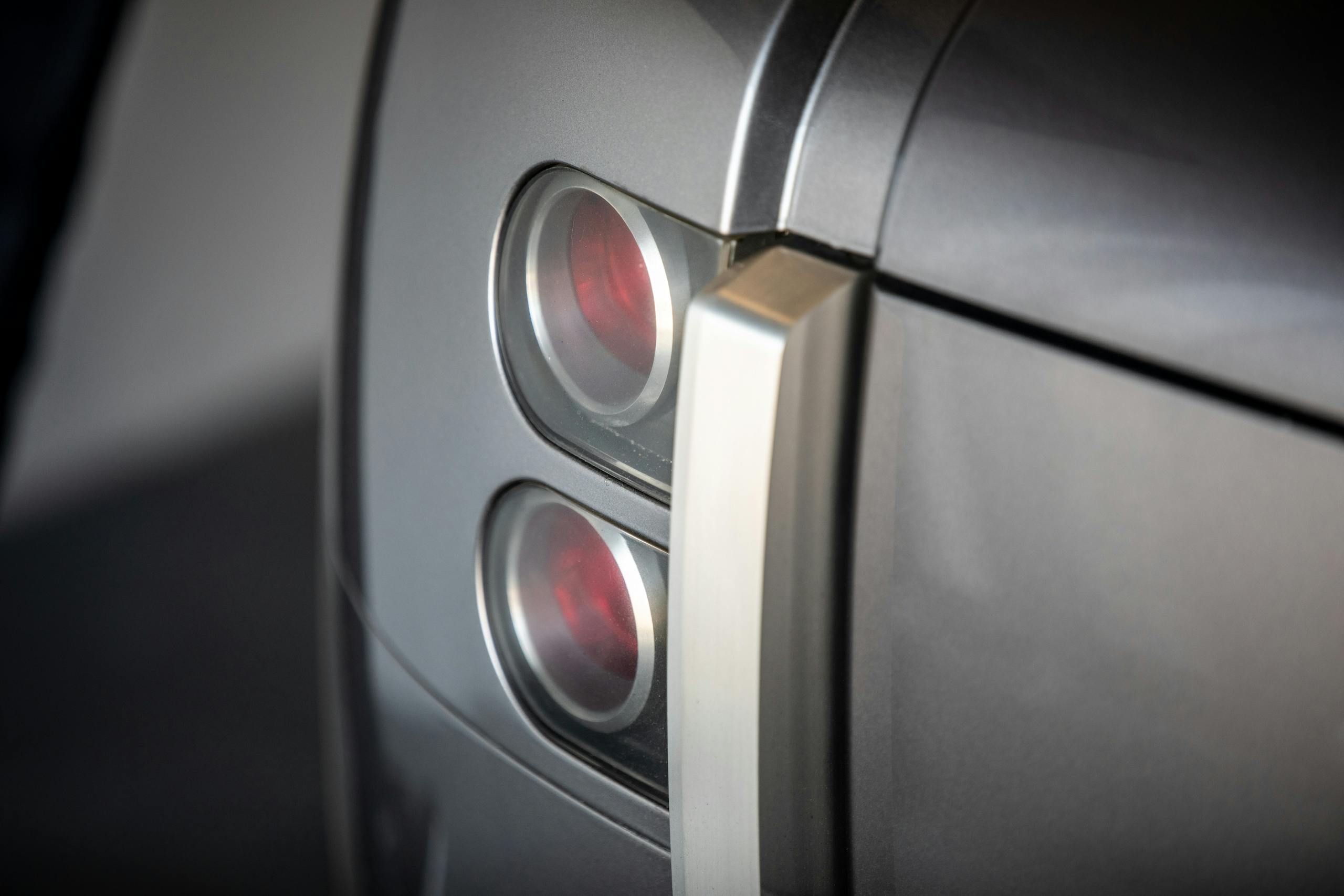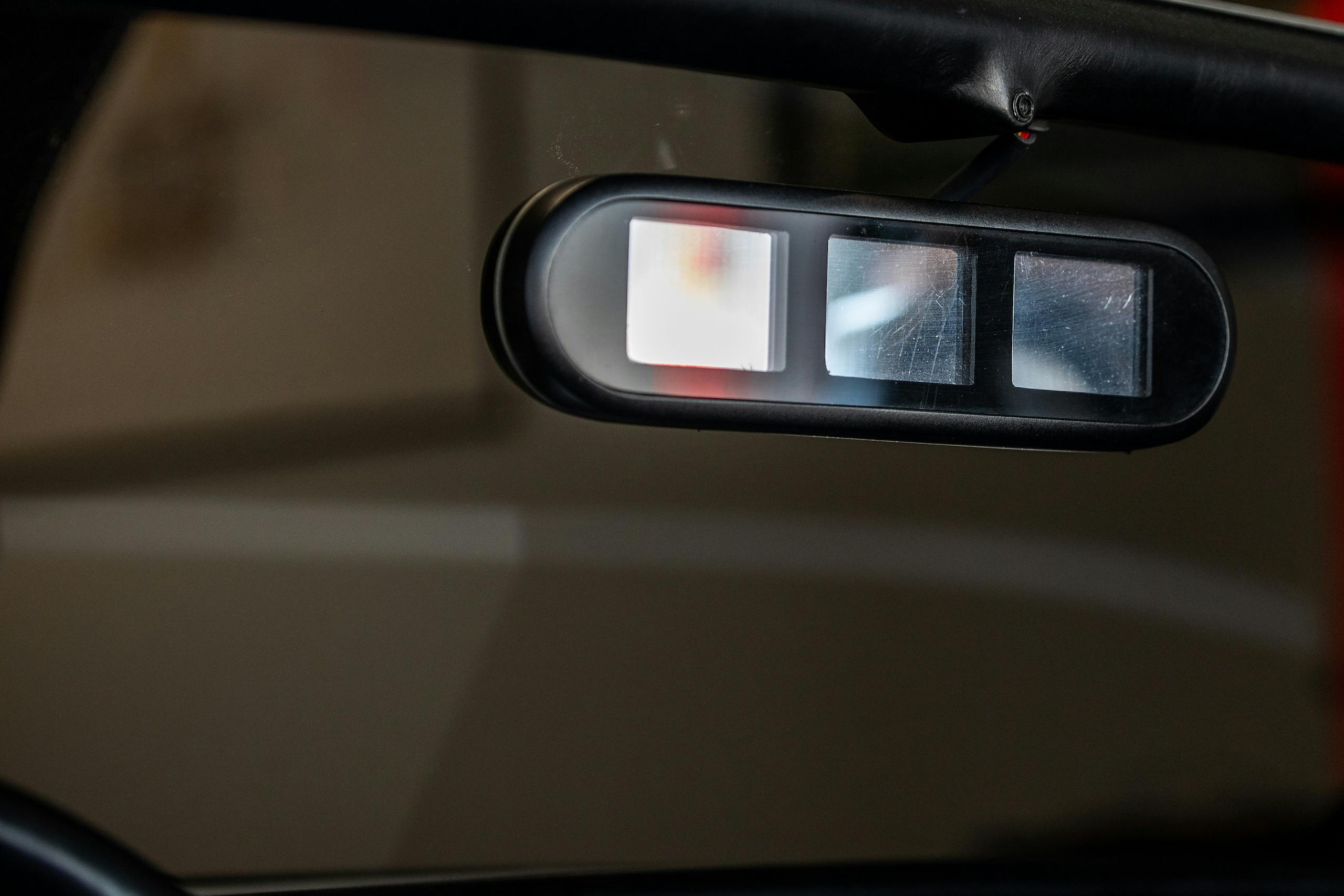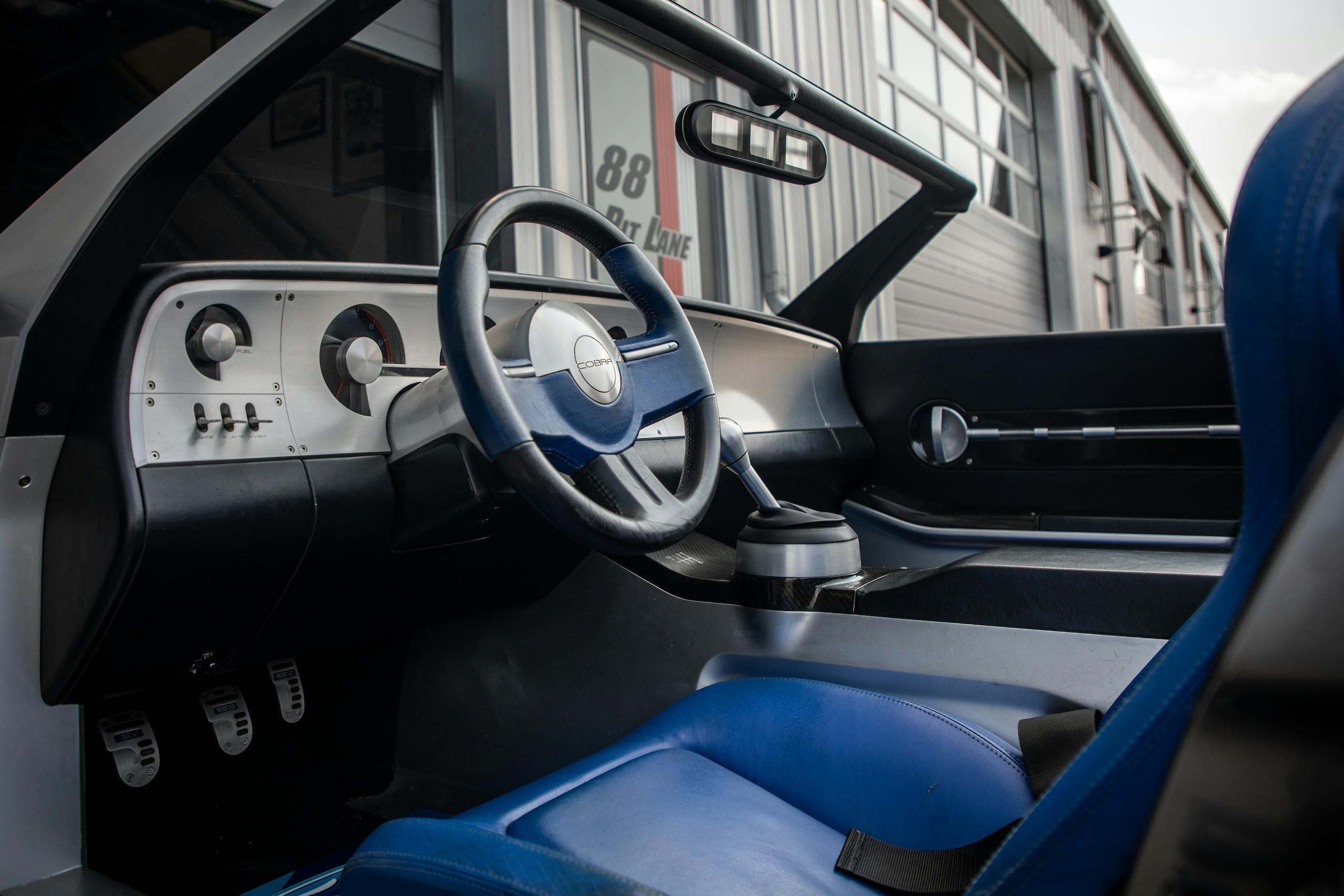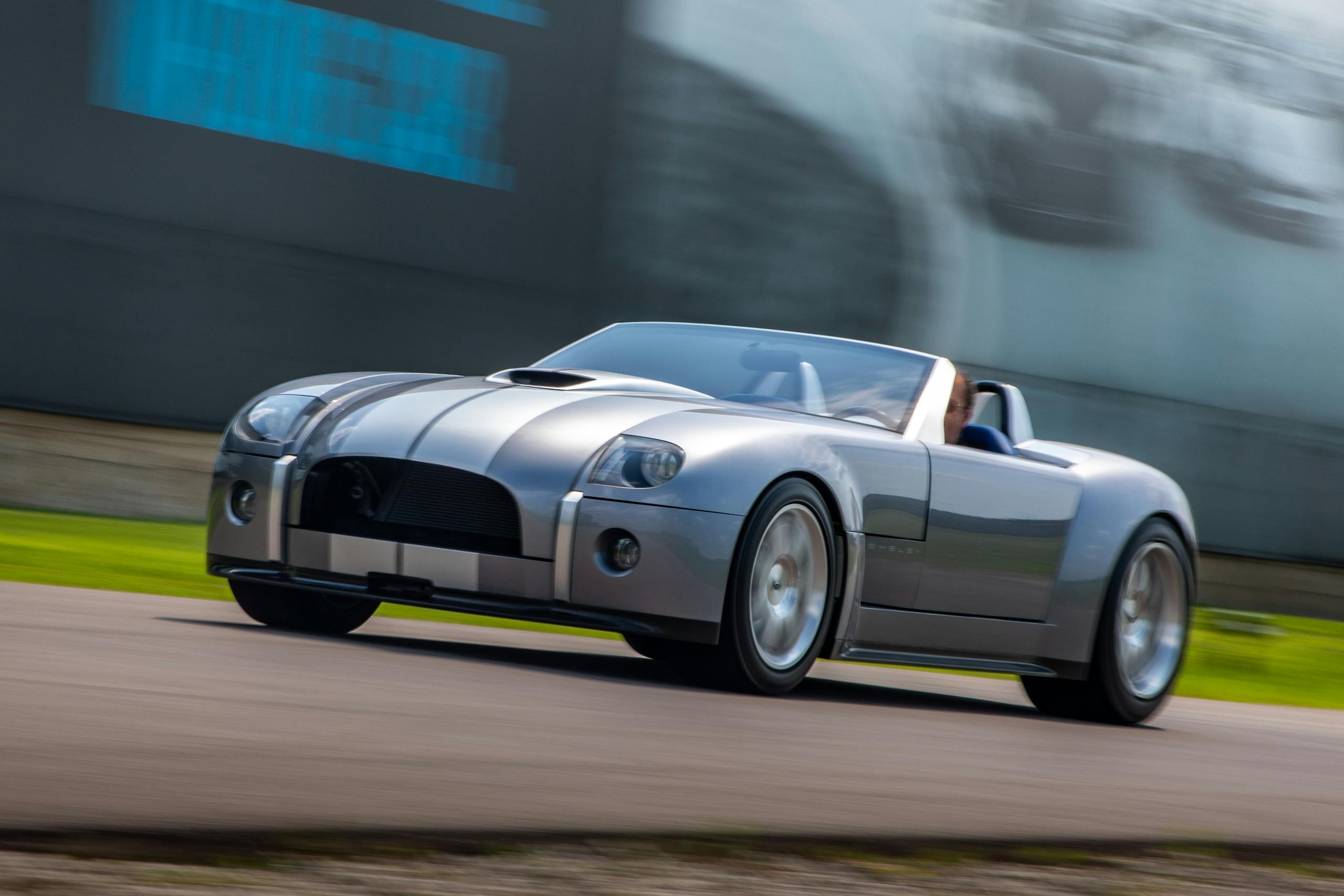Media | Articles
A ride in the ’04 Shelby Cobra concept proves it’s even more go than show
The silver roadster creeps backwards out of the single-bay garage door, ten cylinders exploding into distinctive, dissonant waves of sound. What was once a piece of design eye-candy is now a running, heavy-breathing road car with serious presence. Ahead of the Mecum’s Monterey sale on August 14, we were invited to an up-close encounter with one of Ford’s most memorable concept cars. The man who invited us to this rare ride inside a famous show car, retired automotive engineer Chris Theodore, is already in the driver’s seat. His one hand is on the wheel, the other on the Cobra’s polished aluminum shifter ball.
Like a bonafide fangirl, I am giddy at the prospect of finally hitching a ride in a car that I had only ever seen in magazines or driven with PlayStation controller. As the car clears the garage door frame I can locate no external door handle, so I reach inside to search for something resembling one. Theodore lets me fumble with the ring-shaped handle for a moment before demonstrating where to pull on the driver-side door. Once nestled into the bright blue Sparco bucket seat, we tear off, speeding down the service road at Michigan’s M1 Concourse in Pontiac.
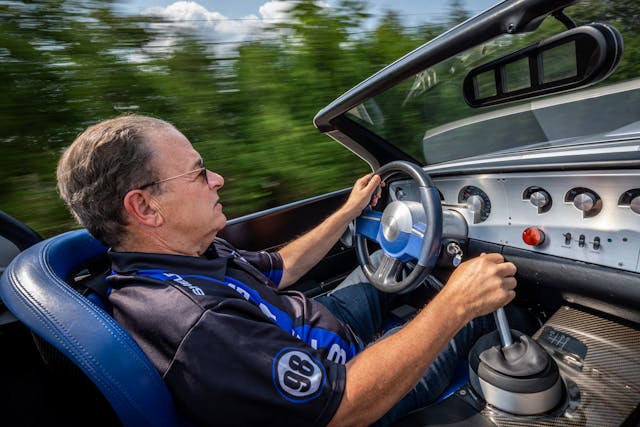
Following the success of the Ford GT concept that bowed at the 2002 North American International Auto Show in Detroit, Theodore and designer J Mays collaborated on a new project codenamed, “Daisy.” The duo, backed by a skunkworks cast of designers, engineers, and advisors from John Coletti to the one-and-only Carroll Shelby, set to work on a modernized Shelby Cobra concept. The project would utilize Ford’s performance parts bin and in turn offer a whiff of the GT production car to come. By 2004’s Detroit show, the concept was stage-worthy enough for Bill Ford Jr. and Carroll Shelby to reveal the retro-inspired Cobra to the press, shaking outstretched hands over the roadster’s large hood scoop.
Back at M1, Theodore presses the Sparco-emblazoned throttle pedal further to the mat. Ten bangs per rotation through an X-pipe exhaust makes for one hellacious concert; as we accelerate, I am pushed into the seat back, straining to focus on the orange tach needle swinging along the arc of its clockwise climb. “It’ll do 7500, easy,” shouts Theodore over the V-10.
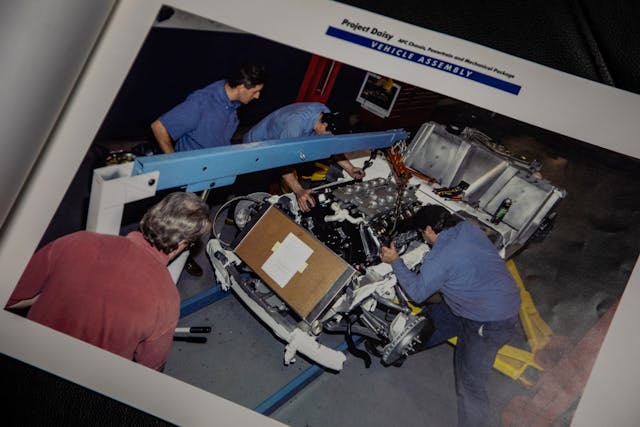
That engine: Back when Theodore and crew fabbed the Cobra, they stuffed an all-aluminum 6.4-liter V-10 between the rails, behind the front axle. One of four such engines built (the three others were used in other test cars and concepts like the Ford GR-1), the 605-horsepower dry-sump beast is linked to a Ricardo transaxle mounted out back. That leaves room for plenty of footwell, and the center console is only the width and shape of a tall ammo box.
Marketplace
Buy and sell classics with confidence
The sleek aluminum and composite interior still looks enticing in 2021, despite the 16 years of age. Any exposed seams come across as cosmetic, meshed into the retro-futuristic industrial aesthetic. The dash, one solid piece of aluminum actually scored to mimic several plates, houses seven gauges all shaped as three-quarter circles. Light and latch switches sit rank-and-file below. The polished red button on the center of the dash looks like something used to fire missiles, but it in fact performs the opposite function—a kill switch that serves as a nod to Shelby racing heritage.
From the passenger seat, any notion that this concept is a paper tiger fades away at speed. The Cobra, riding on slicks, moves like a fully-formed road car. Theodore proudly notes that chassis stiffness (at 10,060 lb/ft per degree) exceeded that of the Corvette at the time of the reveal. “No ordinary push-mobile, or 15 mile-per-hour electric cart, Daisy’s body had to withstand race car stresses,” wrote Theodore in his book The Last Shelby Cobra.
Given the show car’s true capabilities, it’s hard to believe Ford converted it into a rolling paperweight. Yes, Ford did hang onto the Cobra concept for several years before deciding to sell it to raise money for the restoration of Henry and Clara Ford’s Fair Lane house, in 2016. When Theodore first heard the news, he couldn’t believe it. “I thought this can’t be right,” said Theodore. “Ford doesn’t sell their premium concept cars.” It was true, and that wasn’t even the worst of the news. Lawyers advised Ford Motor Company to disable the car prior to sale; the driveshaft’s splines were welded inside the torque tube and then the bolts to the torque tube access plate were ground off. Talk about throwing away the key. Rumor has it that Ford even entertaining the idea of pouring concrete down the cylinder bores. Fortunately nobody went that far, but the company did affix a plate on the door sill that reads:
“NOTICE: This Lot was designed and built for display purposes and to gauge public reactions to various design elements. Despite its appearance, it has not been engineered to be driven on public roads …”
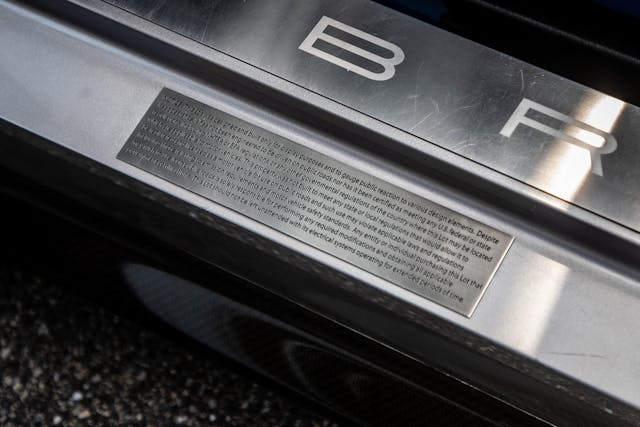
None of this dissuaded Theodore, who attended the Cobra’s auction in Greensboro, North Carolina in pursuit of the car. His max high bid was quickly decimated. Dejected, he slunk away from the stage to meet his wife in the stands. “She said, ‘you’re only going to have once chance to get it’, so I did” says Theodore. “and it was the craziest thing I’ve ever done in my life. I didn’t sleep for a day.” Theodore took two mortgages on his houses to finance the $825,000 hammer price.
Once we’re safely back in the garage, I ask about Carroll Shelby. “He was my boyhood hero,” Theodore says of the man he first met while working on the Viper at Chrysler in the late 1980s. The two eventually became very close during Cobra development and worked on projects together after Theodore’s retirement in 2004. Owning the Cobra concept brought everything full circle. “It was a dream come true.”
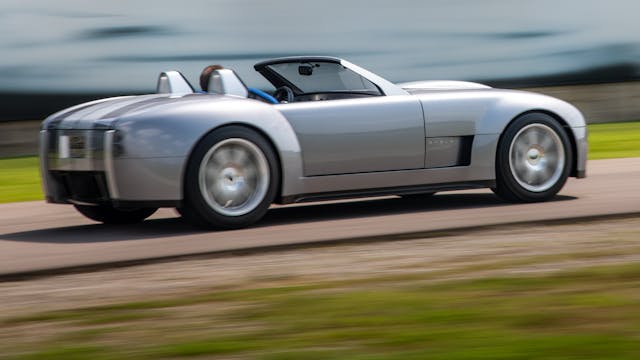
In the years following his landmark purchase, Theodore worked tirelessly to make the roadster road-legal. He enlisted Technosports, a company from nearby Livonia, Michigan that originally built the Cobra’s chassis, to fix the driveline issues. The clutch was also replaced (a casualty of Carroll Shelby’s burnouts during a 2004 photoshoot). Perhaps the most important addition to the car since the purchase are two slips of paper—title and registration. The Cobra concept received fresh fluids and heavy cleaning prior to its debut as a road-goer at Amelia Island in 2018.
Despite the overhaul, the car wasn’t running as well as Theodore had anticipated. “It seemed like it had a rev-limiter on it. It would buck and spit,” said Theodore. He recalled the mad rush to complete final assembly on the car back in the day, driving him to hunt for more issues. Sure enough, in his words, “the wiring harness was a rat’s nest.” When Theodore and crew untangled the wires, they also found a black box labeled, “U, V, L.” Unlimited, Valet, and Limited to 100-mph. “We threw that box out,” he said, smiling.
All that time, all that work, invested into a dream car—why sell? Among Theodore’s reasons, one in particular demonstrates his reverence for irreplaceable roadster. “I don’t want the burden of protecting it. It takes somebody with a bigger pocket book to do that.”
The retired engineer also plans to use the cash to fund other projects, including the Super Snake II—a carbon-fiber Cobra body (provided by Carroll Shelby) with Ford GT concept running gear, riding on a Theodore-patented chassis. Unlike the Cobra concept, Theodore’s new projects will offer more freedom, unburdened by the anxiety of protecting a one-of-one concept. “I won’t be scared of driving these cars. I can build them, rebuild them, I can do what I want with them. I won’t be taking a huge piece of history and putting it in jeopardy.”
Finally, Theodore simply feels that his chapter with the Cobra is at an end. “I achieved everything I wanted to do … I didn’t want the car being in some collection, collecting dust, undriveable,” said Theodore, his hair windswept from the high-speed open-air cruise. Without question, he accomplished that mission. With any luck, the next owner will honor his wishes and let the roadster rip, its ten-cylinder snarl filling the air.
